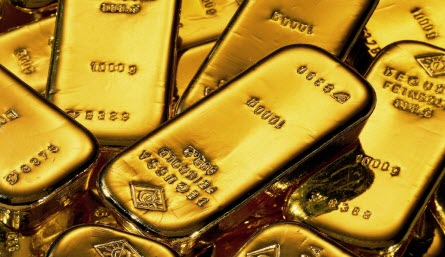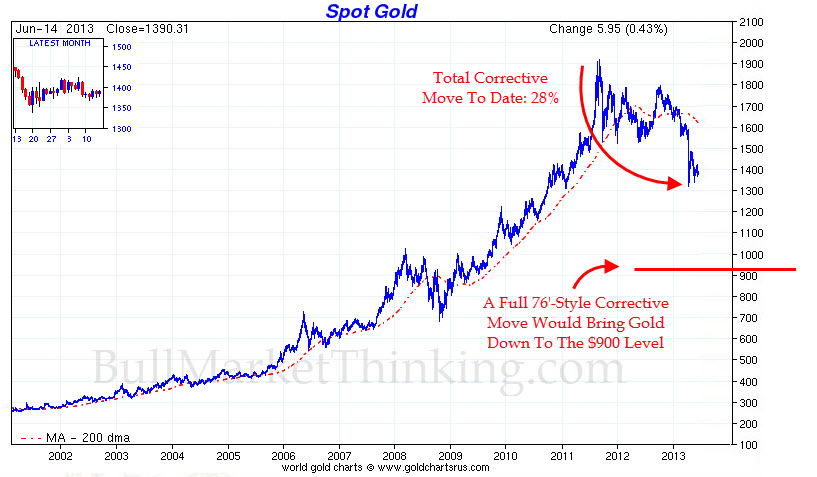
Winston Churchill is famously known for having said, “The further back you look, the further ahead you can see,” and indeed, historical precedent is one of the few tools we have at our disposal when studying major market trends, and in today’s case, the trend in gold.
The period most widely referenced and compared to today’s bull market, is the late 1970s. During this decade, gold moved from $35 an ounce, to an intraday peak of over $900 an ounce in January 1980, for a total move of roughly 26x.
When we look at today’s bull market in gold, which has moved from a bottom of $250 an ounce, to where it stands today, at $1400 an ounce—we see a 5.5x total move—a fraction of the 26x move witnessed during the 1970s.
But why is it that today’s bull run seems so much more challenging than its 1970s predecessor? Why is there so much more volatility? Why is there so much more “manipulation”, “panic”, and every other nasty thing involved, that wasn’t present back then? The answer is: there isn’t.
Today’s bull market in gold is tame, quiet, and moving along just as one would expect it too. It only feels emotional because you’re living through it.
Furthermore, today’s ongoing and two-year consolidation in gold is nothing when compared to the mid-cycle correction displayed during the 1970s.
As previously mentioned, yesteryear’s bull market unleashed gold from its pen in 1970 at $35 an ounce. It barreled forward to $180 an ounce by 1974, achieving a 500% total move, before taking a short pause.
It was then on August 14, 1974 that an interesting event occurred; standing President Gerald Ford signed a bill lifting the previously observed “Executive Order 6102”, which banned gold ownership by U.S. citizens, scheduled for effect on December 31st, 1974.
For the first time in a generation, Americans were allowed physical ownership of gold bullion coins and bars. In anticipation of gold’s liberation day, a blow-off “peak” up to $195 an ounce took place, no doubt allowing the inside holders (banks and governments) to rotate out of positions purchased at $35 an ounce—in effect, dumping them out into the public at new all-time highs.
Following its December liberation day, gold collapsed by 48% over the next year and a half, from a high of $195 an ounce, to a bottom of $100 an ounce in August, 1976.
Panicked sellers were softly coddled by mainstream financial firms in their decision to sell, no doubt representing the perfect re-entry point for smart money to buy back previously sold gold to the American public in the ensuing run up.
Within days of a bottom being struck at $100 an ounce, Citibank issued a statement indicating that, “The economic recovery that is now under way in most countries will likely continue for the next year, gold will lose some of its allure as an investment…[and] with inflation on the wane…[we] foresee the possibility of a price as low as $60 an ounce.”
That statement marked “the end” of the gold bull market for most, and indeed, the great majority washed their hands clean of yet another failed investment scheme delivered to the public, backed by the full faith of the U.S. Government and banking powers.
However, for a select few, the true story of power and excitement began in that $100 bottom in 1976, for the preceding 48% collapse in the price of gold represented a “mid-cycle” shakeout—a point in which the bull shook off all but the toughest and most convicted holders of the metal. It was then, in the ensuing four years from 1976 to 1980, that gold soared from $100 an ounce—to over $920 an ounce.
In looking at this price action of the 1970s, we can be certain that horrific corrections are part-in-parcel of bull markets. Additionally, whether it be by reflection of popular opinion, or by the device of smart-money to re-enter positions—mainstream voices will attack the market, in a most ferocious way, at or very near exact market bottoms.
Furthermore, in the context of this historical market data, it appears the current correction in gold is tame in comparison to the 76′ shakeout, when measured in percentage terms:
To be of equal proportion to the 76′ correction, gold would need to drop down another 35%, to the $900 level. If in fact it did so, it would still remain within its long term bull market given the fundamentals.

For those looking for a bottom at today’s levels, it’s most certainly a possibility when looking at headlines coming from mainstream financial firms as an indicator. For example:
April 23rd, 2013 – Goldman Sachs: “Expect further declines…as conviction in holding gold continues to wane…[and] reacceleration in the US growth [occurs] later this year.”
May 16th, 2013 – Credit Suisse: “[Expect] $1,000 in five years…as inflation fails to accelerate and with the worst risks to the global economy waning.”
It should be noted however, that bearish gold commentary has been emanating from the mainstream press all throughout the last two years, with every piece of which further validated as gold continues to its drop.
As a final visual comparative on gold—when we look at a chart of the total cumulative gain of today’s bull market (5.5x) versus the 1970s (24x+), we see just how much today’s market pales in comparison.
Bottom Line: The emotional challenge of remaining positioned in today’s gold bull market is no easy feat. Adding to that challenge, is continued clamoring by mainstream financial news sources, repeatedly calling an end to the bull market.
If history is to be our guide however, we must understand that bearish calls are part of the journey, as well as the steep and frightening declines.
Aided with history, these times need not be emotional—they are in fact quite normal, and gold is moving along as expected.
Most importantly, is you’re response to the variables of today’s market. Your actions will determine whether or not this is just another failed investment scheme, or the resumption of a powerful and profitable journey.



 Follow us on Twitter
Follow us on Twitter Become our facebook fan
Become our facebook fan











Comments are closed.